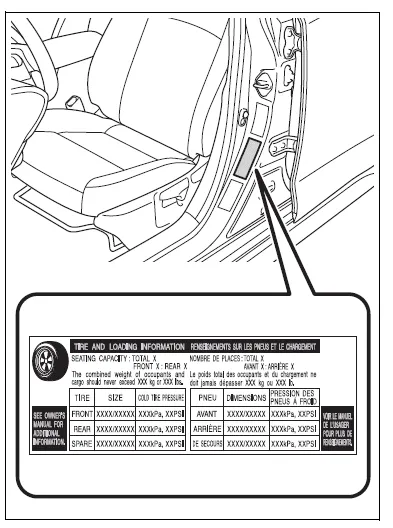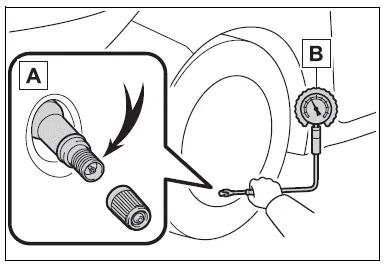Toyota Corolla (E210) 2019-2025 Owners Manual / Maintenance and care / Tire inflation pressure
Toyota Corolla (E210): Tire inflation pressure
Checking the specified tire inflation pressure
The recommended cold tire inflation pressure and tire size are displayed on the tire and loading information label.

Inspection and adjustment procedure

- Tire valve
- Tire pressure gauge
1. Remove the tire valve cap.
2. Press the tip of the tire pressure gauge onto the tire valve.
3. Read the pressure using the gauge gradations.
4. If the tire inflation pressure is not at the recommended level, adjust the pressure.
If you add too much air, press the center of the valve to deflate.
5. After completing the tire inflation pressure measurement and adjustment, apply soapy water to the valve and check for leakage.
6. Put the tire valve cap back on.
■Tire inflation pressure check interval
You should check tire inflation pressure every two weeks, or at least once a month. Do not forget to check the spare.
■Effects of incorrect tire inflation pressure
Driving with incorrect tire inflation pressure may result in the following:
- Reduced fuel economy
- Reduced driving comfort and poor handling
- Reduced tire life due to wear
- Reduced safety
- Damage to the drive train
If a tire needs frequent inflating, have it checked by your Toyota dealer.
■Instructions for checking tire inflation pressure
When checking tire inflation pressure, observe the following:
- Check only when the tires are
cold.
If your vehicle has been parked for at least 3 hours or has not been driven for more than 1 mile or 1.5 km, you will get an accurate cold tire inflation pressure reading.
- Always use a tire pressure gauge.
It is difficult to judge if a tire is properly inflated based only on its appearance.
- It is normal for the tire inflation pressure to be higher after driving as heat is generated in the tire. Do not reduce tire inflation pressure after driving.
- Never exceed the vehicle capacity
weight.
Passengers and luggage weight should be placed so that the vehicle is balanced.
WARNING
Proper inflation is critical to save tire performance
Keep your tires properly inflated.
If the tires are not properly inflated, the following conditions may occur which could lead to an accident resulting in death or serious injury:
- Excessive wear
- Uneven wear
- Poor handling
- Possibility of blowouts resulting from overheated tires
- Air leaking from between tire and wheel
- Wheel deformation and/or tire damage
- Greater possibility of tire damage while driving (due to road hazards, expansion joints, sharp edges in the road, etc.)
NOTICE
■When inspecting and adjusting tire inflation pressure
Be sure to put the tire valve caps back on.
If a valve cap is not installed, dirt or moisture may get into the valve and cause an air leak, resulting in decreased tire inflation pressure.
Other materials:
Handling of hose clamps
Before removing the hose, check the depth of the inserting
portion and the clamp position in order to restore it
surely.
change a deformed or dented clamp for a new one.
in case of reusing the hose, install the clamp on the hose
where it has a clamp track.
for a ...
Cleaning and protecting the vehicle exterior
Perform the following to protect the vehicle and maintain it in prime condition:
● Working from top to bottom, liberally apply water to the vehicle body, wheel
wells and underside of the vehicle to remove any dirt and dust.
● Wash the vehicle body using a sponge or soft cloth, such a ...
Inspection procedure
1 Check p squib circuit(airbag sensor assy center – instrument
panel passenger airbag assy)
Disconnect the negative (–) terminal cable from the battery,
and wait at least for 90 seconds.
disconnect the connectors between the airbag sensor
assy center and the instrument panel ...


